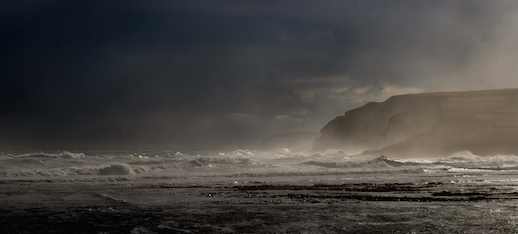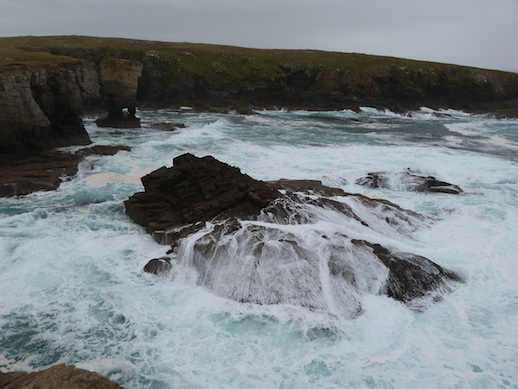 Eastside surf. Photo: Sarah Sankey
Eastside surf. Photo: Sarah Sankey
Words: Steve Sankey.
For weeks now the islands have been lashed by southerly gales, sometimes with a touch of easterly, or conversely with a touch of westerly. No matter, the sandstone cliffs of the archipelago take their punishment anyway, along with we locals and any hardy livestock still outside. There are few trees beyond the towns and villages to help slow the air. These were removed by our Neolithic ancestor farmers almost 6,000 years ago, who have left us their legacy of uncluttered skyscapes and seascapes.
Some wildlife manages to eke out a living in the deep mid-winter. Into the relative calm of Scapa Flow, perhaps Britain’s finest natural harbour, come countless numbers of sea-duck. Great-northern divers, Slavonian grebes and long-tailed duck are common. Less common but usually present are the rare white-billed divers from the Arctic and red-necked grebes. Once the gales do set in, strange visitors are blown in such as little auks, barely starling-sized seabirds which breed in the far north in Greenland and Svalbard. They don’t always make it and sometimes their corpses punctuate road verges or gardens. The wonder is that this tiny seabird can negotiate these gales at all.
 Yesnaby Castle in heavy seas, West Mainland, Orkney. Photo: Steve Sankey
Yesnaby Castle in heavy seas, West Mainland, Orkney. Photo: Steve Sankey
Recently the herring arrived into Scapa Flow, bringing a smorgasbord of camp-followers, including several hundred gannets, guillemots and razorbills; but also a trio of cetaceans in the form of an orca pod, a solitary minke whale, and even two humpbacks. These latter two giants mesmerised us locals, who turned out in their hundreds to see them. They lunge fed on the herring, tossing an occasional languid flipper or tail fluke into the air to delight their watchers. The large whales, humpbacks and sperm, are infrequent visitors to Orkney, but occur occasionally, along with the more common minke and orca. Several dolphin species also visit, though they are not so easily seen in the winter seas.
And then suddenly the wind drops, and the islands are becalmed on the junction of the Atlantic and the North Sea. We can all breathe again, and the ravens and even the sea eagles will take to the skies, re-forming their pair bonds in precocious courtship displays. Both these species are very early nesters, and there may sometimes be frost or even snow on the crags as the birds begin to incubate their eggs. The sea eagle last bred in Orkney well over a century ago, so their return to Hoy last year was most welcome. Both parent birds are young and untagged, so we have no idea whether our colonisers are from reintroduced Scottish stock or else are of Norse origin. Either scenario is possible, but the romantic in me wills them to be Viking, just like our forebears who colonised the islands so vigorously a thousand years ago.
Steve Sankey is a freelance journalist and wildlife tour guide in Orkney.